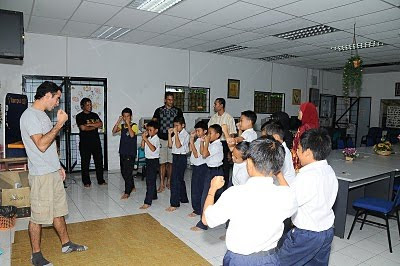Coincidently in conjunction with the miri city z1 wourld muay thai tournament at Miri stadium nearby, just 250 meter from the school. Mr Mohd Zul-fiqar (Sk Sayed Othman Muay thai trainer) invited Mr Musaddik Zainuddin (Boxxtomoi consultant) and two famous Muay thai player, to give a special talks about Muay thai.and encourage the student to know more closely about Muay thai .
Special thanks to Mdm. Hjh Wan Dahili (priciple), for allowing us to interact with the students under the guidence of Mr Mohd.Zul-Fiqar Mat Yunus.
Thank you to Miri City Z1 champion Abbas Ahmadi (Trainer & Fighter for Z1 BoxxWarriors MT Gym KL) & Barbod for helping on this community project.
Sk Sayed Othman Muay thai club was establish in January 2009 with 6 student. The establish of Sk Sayed Othman Muay Thai Club is still under Persatuan Silat Melasar (Melayu Sarawak),under the guidence of Mdm Mary Ann Nasos (Silat) and Mr. Mohd Zul-fiqar (Tomoi).
One of our succesful performence was held at Dewan Suarah Miri. Three of our Sk Sayed Othman Muay thai club student, was perform their basic Muay Thai martial art at Open Area Dewan Suarah in Miri at 18.11.2009.
The school administrator : (L) Mdm Mila (HEM), Mdm. Hj.Wan Dahlia (HM),Mdm Maryann (PK Kokurikulum) and Abbas Ahmadi Boxx Warriors KL.
Barbod.. remember boys..stay away from drug !
The next champion. an opportunity to touch that thing.
From left : Mohd Zul-fiqar, Musadik Zainuddin, Abbas Ahmadi, Nurmila, Mary Ann and Borbod
Sk Sayed Othman Muay Thai Club Student.
Abbas..this is how we do it!
Sk Sayed Othman Muay Thai Club Logo.
location Muay Thai Z1 world champion and Sk Sayed Othman
Small school, Big heart
Sk Sayed Othman at night


















